Curriculum mapping is an essential skill for educators. Curriculum Mapping ensures a teacher teaches all the standards for the grade level by mapping out what you are teaching for the whole school year. This will save you a lot of time lesson planning every week. Sometimes, a curriculum map is given by your county or state. But you can easily create a curriculum map yourself that is tailored to your own classroom, I will include all steps below!
A curriculum map is used to map out your curriculum for the entire school year. Basically, you need to include all standards and how you plan to teach each standard, which could be as simple as a lesson in your textbook. Then, you can include when you are going to teach each standard. Seems like a lot, but once you do it, you will be way more prepared for the school year.
Curriculum maps can benefit every teacher. Homeschoolers should also create a curriculum map. You want to do what is best for your students or your children, so being prepared and having a plan will help you successfully teach!
Having a curriculum map for each subject will ensure that you teach every standard/skill needed in your grade level during the school year. It will also make weekly lesson planning so much easier!
I realize that things come up and you may “get off track” but having a plan already planned out will make it much easier to get back on track. Also, you will know exactly what you have taught and exactly what you still need to teach.
Here are the steps that I follow to create my curriculum maps. I like to make a curriculum map for every subject I teach. I will walk you through the steps as clearly as I can, and I will also include some pictures as well. If you want even more help, you can buy my complete fourth grade curriculum map set that is completely editable here. So, you can edit it to fit your standards, but have that template to start from.
1. Decide what you are teaching.
For most public school teachers, this is an easy step. You will teach your state’s standards for your grade level.
For other teachers that aren’t mandated to teach standards or homeschoolers, you may have to do some research. I highly recommend everyone at least look at the state standards for your grade level. A lot of research and thought went into those state standards, so it is a great resource to use. If you decide to teach the state standards, you can choose ANY curriculum you want. You do not have to use the curriculum public school uses.
Curriculum is the everyday lessons you will teach. The standards are the learning objectives and goals. A fourth grade standard is to add fractions with common denominators. You can choose whatever way you want to teach that standard, but all fourth graders need to have that skill.
After deciding on the standards and curriculum you will use, you will need to read each standard and make sure your curriculum teaches it at some point. You may have to supplement with online resources or other curriculum, but at least you will know how many standards you may need to do this for.
2. Select an ordering method to organize how you will teach it.
Once you know what you are going to teach, you will need to organize the order in which you will teach it. If you use your state standards or Common Core standards, the order of the standards is usually the best way to teach the standards. The first math standard should be taught before the second math standard. Now, sometimes the standards are grouped into bigger categories. So, you could decide to teach all the Geometry standards before you teach the Fraction standards and that would be fine, as long as the standards under the Fraction section are taught in order.
There are different ways you can order the standards to teach them. Below I will explain each one and which subject it works best for.
Chronological Ordering: You can order your standards in chronological order. This works best for Social Studies. Basically, you will teach your history or social studies standards in order that it happened in history. Now, sometimes you will need to add in Economics, and this could go anywhere in the order.
Priority Ordering: You can order your standards based on priority. This works best for English Language Arts. Students need to have certain skills that are extremely important to learn. In English Language Arts, the skills may be needed at the beginning of the year so they can be practiced all year.
Building Ordering: You can order your standards based on how the student’s knowledge builds. This works best for Math and Science. Certain skills need to be learned first to work on the next skill. These standards will build on the knowledge they learned from the standard prior.
Sometimes, you can follow a curriculum. This way, you don’t have much thought in the order, but you do need to make sure the ordering works best for you and your students.
3. Group Standards based on categories
Sometimes it is easier to group standards or skills in categories. State and Common Core standards are usually already grouped into smaller categories. This just makes it easier to see how many skills you need to teach in each subject. It will also help when ordering your standards to be taught when you have them in groups.
For example, in math there are smaller groups of Operations and Algebraic Thinking, Numbers and Operations in Base Ten, Numbers and Operations Fractions, Measurement and Data, and Geometry. You can order these groups however you want when you are teaching. You many choose to work with Geometry at the end of the year or beginning.
4. Order the groups of standards in the order you want to teach them
Once you have the standards in smaller groups, you can better put them in order. You may want to work with 9 weeks, semesters, or even the whole year. You can plan out weeks or months, or even days if you want to.
For example, in Science you will have groups of Physical Science, Life Science, Earth Science, and Engineering. In fourth grade, there are more Physical Science standards than any other, so I choose to teach those first. This will usually last the first nine weeks and part of the second nine weeks. Then, I focus on Life Science for the majority of the second nine weeks. Earth Science will be taught in the third nine weeks. In the fourth and final nine weeks, I will teach Engineering. This is just an example. You can teach the standards in any order that will work for your classroom and students.
5. Create your map.
When you know what you are going to teach, know the order in which you will teach it, and have the skills separated by groups and time periods, you are ready to create the map. I create my map in Microsoft Word. I usually put my information in Tables. I use the Merge Cells, Split Cells, and Add Cells options a lot. I like how this allows me to easily see the standards and keeps my thoughts organized.
6. Fill in Ideas and Curriculum
When you have completed your map, you can have a section for lesson ideas or curriculum. This is optional, but when I am planning my lessons weekly, this is extremely helpful. I add in the lessons from the textbook that apply. Sometimes, I will add in lesson ideas or materials that I have used in the past.
Examples
Below are some examples of curriculum maps that I have created. These are for fourth grade, but the sections and organization will work for any grade!
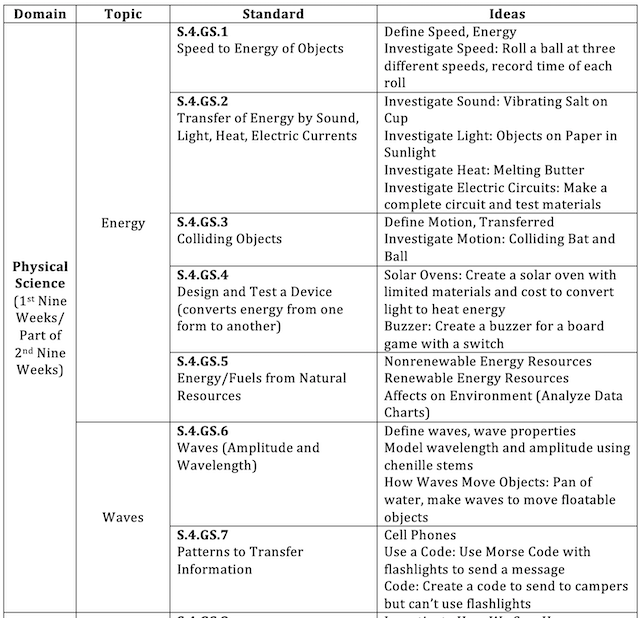
Above is part of my Science Curriculum Map. I divide this map into Domain, Topic, Standard, and Ideas.
The Domains of Science are Physical Science, Life Science, Earth Science, and Engineering. In fourth grade, there are more Physical Science standards than any other, so I choose to teach those first. This will usually last the first nine weeks and part of the second nine weeks. Then, I focus on Life Science for the majority of the second nine weeks. Earth Science will be taught in the third nine weeks. In the fourth and final nine weeks, I will teach Engineering.
The ideas section includes some of the science experiments I do with each standard. I sometimes will include the page numbers out of our science textbook.
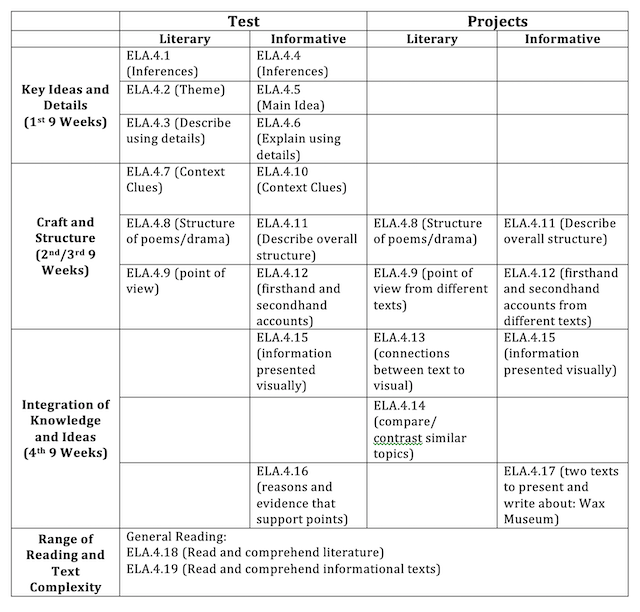
Above is my Reading Curriculum Map. Here I divided some of the big topics (Key Ideas and Details, Craft and Structure, Integration of Knowledge and Ideas) into each nine weeks
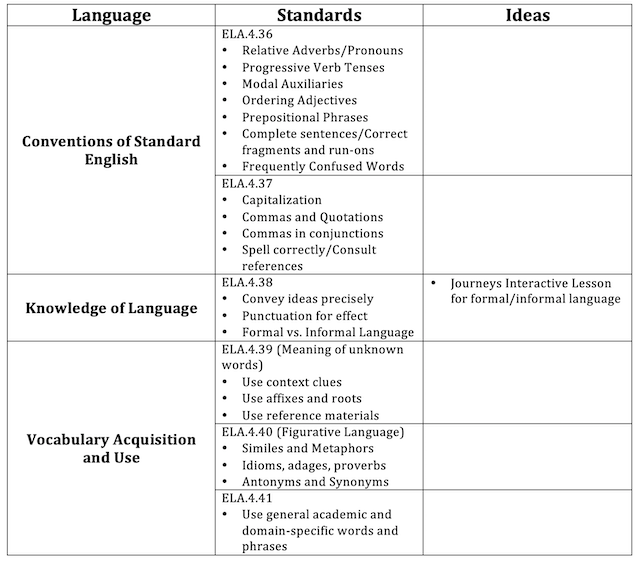
Above is an example from my Language Curriculum Map. This one I didn’t separate into time periods for teaching since there aren’t as many standards. I usually just add them in each week according to what I am teaching in Reading. I will check off what I teach. I still have a section for lesson ideas or curriculum lessons.
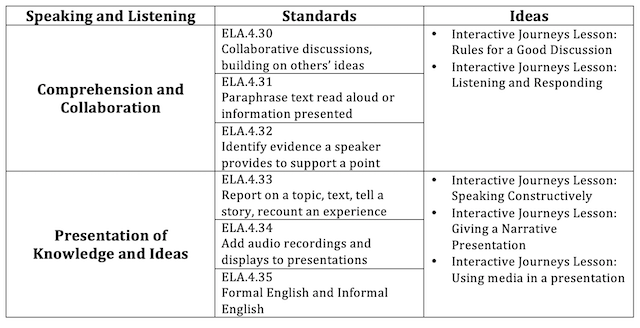
Above is my Speaking and Listening Curriculum Map. I have the curriculum lessons listed so I don’t forget to teach them. These are standards that I constantly look at and make sure I am teaching throughout the whole year.
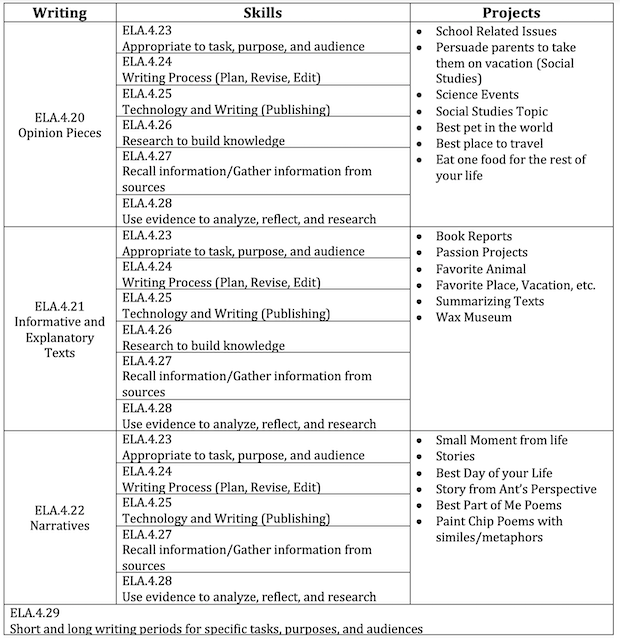
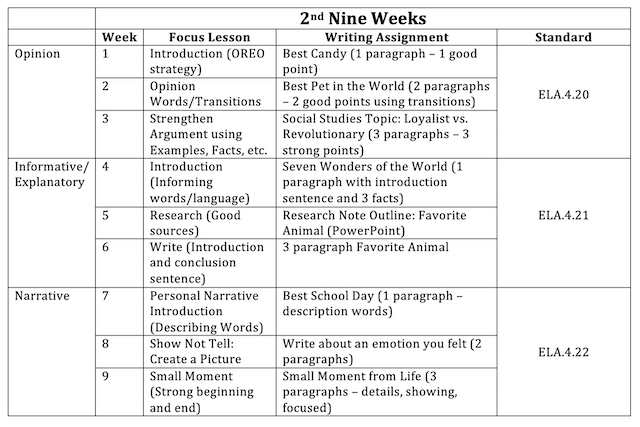
Above is my Writing Curriculum Map. I chose to highlight the three main types of writing standards (Opinion, Information/Explanatory, Narrative). Under those three main standards, I listed all the other writing standards we would be learning and using while doing those types of writings. I also listed writing ideas and prompts that I could use.
I also decided to make a weekly writing map. For the weekly map, I decided to teach Opinion Writing, Information/Explanatory Writing, and Narrative Writing every nine weeks. Each nine weeks, I basically repeat this model with different writing prompts and skills. There aren’t that many writing standards, so this gives the students a writing piece every week. You could also modify this to just one piece of writing every three weeks for each genre of writing.
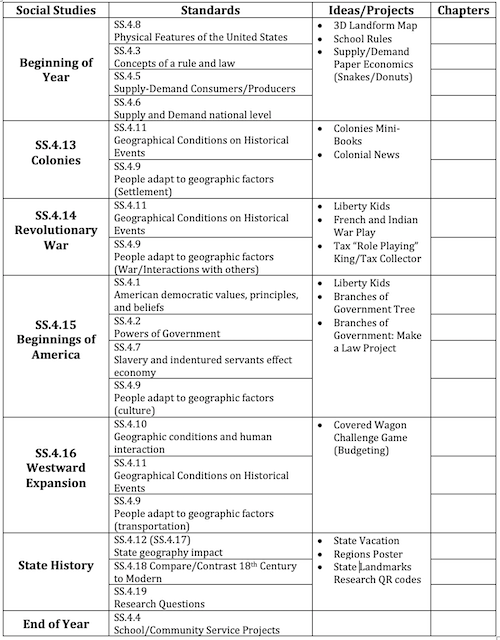
Above is an example of my Social Studies Curriculum Map. For this map, I didn’t put a time frame on it, but it is in the order I want to teach it. I grouped the standards into bigger categories. In each category, I listed some ideas/projects I want to do. I also have a section for the chapters in our textbook that align to the standard.
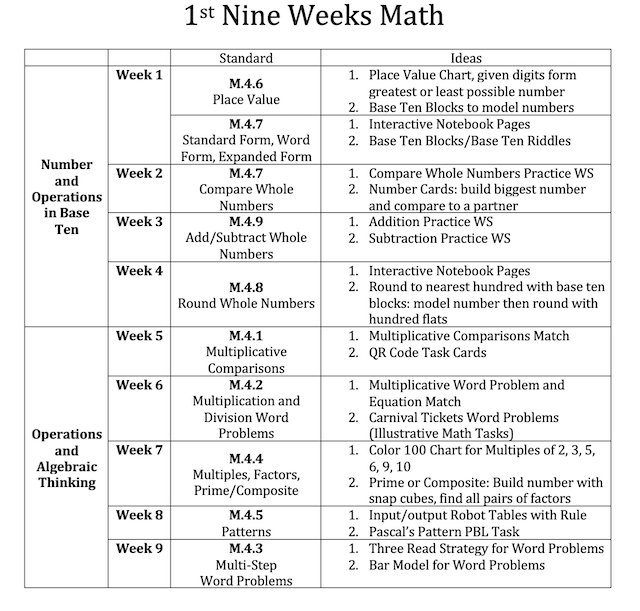
Above is from my Math Curriculum Map. I created a map for each nine weeks. In each nine weeks, I divided it into weeks and put in each standard I want to teach. The ideas are just short notes of extra resources I might use. This map closely mirrors our school’s curriculum, so I use the curriculum for the majority of my lessons and add in as needed for activities or small group work.

I hope you are able to take this information and make your own curriculum maps. This will be beneficial for making sure you teach all the standards/skills for your grade level and save you a lot of time weekly planning!
If you want to read about how I organize all my teaching resources, click here.
If you want to read about how I organize my curriculum maps in my teaching binder, click here.
Thank you for Continually Learning with us!
Kyle and Sarah
